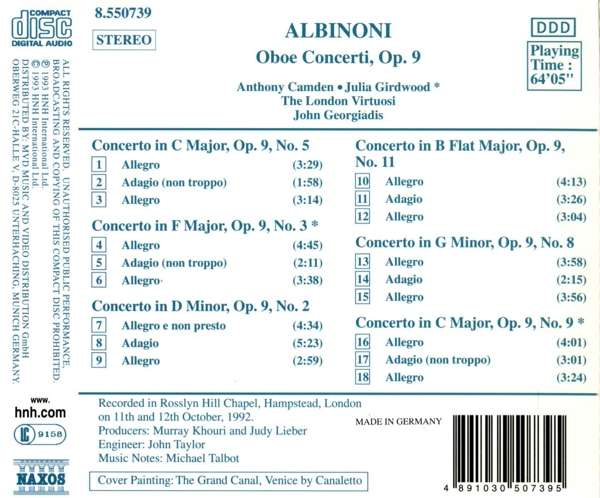
kompozytor
Albinoni, Tomaso
tytuł
Albinioni: Oboe Concertos, Vol. 1
wykonawcy
Georgiadis, John;
Camden, Anthony;
London Virtuosi;
Girdwood, Julia
Camden, Anthony;
London Virtuosi;
Girdwood, Julia
nr katalogowy
8.550739
opis
The Op. 9 concerti are subdivided into four groups, each of which begins with a concerto for solo violin (here the oboe is silent), continues with a concerto for one oboe and finishes with one for two oboes. No. 5, in C major, is a typical specimen of the composer's late style. The orchestral texture is in places highly contrapuntal, but Albinoni never sacrifices tunefulness to a show of learning. Arthur Hutchings, his greatest advocate among British musicologists, aptly describes the finale as 'conveying the allure of the dance without suggesting the street or barnyard'.
F major is one of the traditional keys of the natural horn, which because of its association with hunting was treated as an emblem of the nobility and the courtly way of life. Accordingly, Albinoni, in homage to the Bavarian elector, fills the fast outer movements of the third concerto with hunting calls. The masterpiece of the set is undoubtedly the second concerto, whose long, elegiac slow movement has been dubbed Albinoni's second Adagio'.
The concerti in B flat major (no. 11) and G minor (no. 8) complete the group of concerti with one oboe. Albinoni was very sensitive to the associations of different keys. For him, B flat major is bright and assertive, G minor melancholy and introspective. Similarly, the key of the other ‘double’ concerto in this recording, no. 9 in C major, conforms to a familiar stereotype, being triumphant with a touch of pomposity. Luckily, the slow movements, which in every case are in a different key, provide the necessary contrast and give each work a well-rounded character.
F major is one of the traditional keys of the natural horn, which because of its association with hunting was treated as an emblem of the nobility and the courtly way of life. Accordingly, Albinoni, in homage to the Bavarian elector, fills the fast outer movements of the third concerto with hunting calls. The masterpiece of the set is undoubtedly the second concerto, whose long, elegiac slow movement has been dubbed Albinoni's second Adagio'.
The concerti in B flat major (no. 11) and G minor (no. 8) complete the group of concerti with one oboe. Albinoni was very sensitive to the associations of different keys. For him, B flat major is bright and assertive, G minor melancholy and introspective. Similarly, the key of the other ‘double’ concerto in this recording, no. 9 in C major, conforms to a familiar stereotype, being triumphant with a touch of pomposity. Luckily, the slow movements, which in every case are in a different key, provide the necessary contrast and give each work a well-rounded character.
nośnik
CD
gatunek
Muzyka klasyczna
producent
Naxos
data wydania
23-03-1993
EAN / kod kreskowy
4891030507395

(Produkt nie został jeszcze oceniony)
cena 58,00 zł
lubProdukt na zamówienie
Wysyłka ustalana indywidualnie.
Darmowa wysyłka dla zamówień powyżej 300 zł!
Darmowy kurier dla zamówień powyżej 500 zł!
sprawdź koszty wysyłki










































